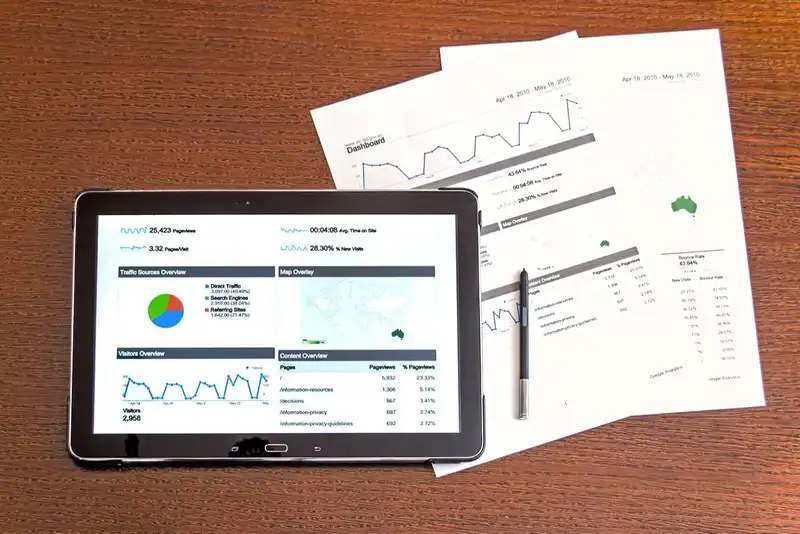What are business intelligence tools?
There are many business intelligence tools available to help organizations make better decisions. Some of the most popular business intelligence tools include data warehousing, data mining, and OLAP (online analytical processing).
5 Ways to Revolutionize Your Digital Marketing With Business Intelligence Tools
What are Business Intelligence Tools?

Business intelligence (BI) tools help companies get a ringside view of their data. It helps them make data-driven decisions for the overall improvement of their operations. With the help of BI technologies, a company can understand market trends, track customer behavior, forecast future events, and optimize business processes. A business can also use it for sandbagging against risk by monitoring key indicators and flagging potential problems early on.
Business intelligence software help businesses aggregate data from different data sources in order to get a bird's-eye view of their operations. Common features of business intelligence platforms include dashboards, reporting, and data visualizations. The top business intelligence tools enable a company to drill deep into data. For example, one can set alerts for data exceptions through cloud computing, apply analysis such as moving averages and regression to highlight trends, and use time-series data to scan large datasets to understand anomalies.
For instance, a business analytics software like Zoho Analytics, an analytics platform that helps with data visualization, can help a restaurant business get answers to questions like- What is our most popular menu item? How have sales been faring over the past year? Which day-part has the maximum business potential?
Top business intelligence software solutions crunch big data and integrate it to give users the information they need to make better decisions. As a result, business intelligence (BI) gives businesses more insight into their operations. In addition to collecting data, BI tools can predict upcoming trends using machine learning algorithms, natural language processing, and BI reporting. They allow businesses to make adjustments before they lose money.
Having said that, it is important to know that BI software technology is always developing. It is an ever-transforming and evolving landscape. And it is precisely this that makes it difficult to keep up with new trends in the BI terrain. Therefore, for a business to use a BI tool to its optimum, it's always better to understand one's business requirements before implementing the tool.
What is Digital Marketing?
There are many reasons why a smart marketing strategy is necessary for restaurant businesses. For one, the restaurant industry is extremely competitive, and the space is becoming increasingly populated, with more restaurants opening daily. IBIS World reports that as of 2022, there are 155,448 single location full service restaurants in the US -- an increase of 2.2% from 2021.
Some of these restaurants are concept-based, some promise speedy service, and some create experiences. These marketing hooks work for these businesses. But those that don't have a solid marketing plan will find their businesses lagging behind, and may even have to shut down.
It is important to note that as the restaurant landscape evolves with better resources and technology, diners have become more aware of their options. They have, consequently, become more picky about where they spend their money, and therefore have better bargaining power. In 2021, Modern Restaurant Management reported that 34% of diners chose to dine at restaurants after going through peer-reviewed websites. And 53% of 18- to 34-year-olds factored in online ratings and reviews before making their dining decisions.
Social media and online review sites have fuelled the trend even more. It's easier than ever for diners to share their experiences with others -- good or bad. Restaurants must therefore find ways to stand out from the crowd in order to attract new customers and retain old ones. A well-thought-out digital marketing strategy is the need of the hour.
In layman's language, digital marketing promotes a product or service with the help of digital technologies. It is an umbrella term for a company's online marketing efforts. It mainly encompasses anything on the internet -- from email, to search engine optimization (SEO), and also includes mobile phones, display advertising, or any other digital medium.
However, several factors need to be taken into account when creating a digital strategy -- it's important to understand the target audience; it is also important to consider what type of atmosphere the restaurant will have and how one will convey that via marketing material.
The primary goal is to reach more people cost-effectively. For example, a business can track the number of people visiting its website, the duration they stay on the site, the pages they view, and the links they click. With this data, the business can engineer the digital marketing strategy to reach the right audience with the right message.
It's crucial to create an integrated marketing plan that includes various tactics like online ads, social media campaigns, and traditional print advertising. Top businesses use different channels to reach a larger audience and generate more sales.

Intelligent, cloud-based reporting meets enterprise-class reliability.
Meet PLUM Point of Sale, an affordable and reliable alternative to traditional Point of Sale software.
BI Tools Restaurants Can Use in Their Marketing

Various business intelligence tools can help restaurateurs collect and analyze data to make better-informed marketing campaigns. The market is flooded with business intelligence software tools, and the one you choose should fit well with your goals and help you with business intelligence automation. Here are some that are well-suited to create digital marketing initiatives for the restaurant industry-
- BI Analytics- BI Analytics tools can track website traffic and mobile app engagement and help you understand how customers interact with your brand. This information can improve your restaurant's online presence and drive in more customers. The data gathered with such tools (Google Analytics, for example) can also help you identify areas of improvement for your digital marketing efforts.
- Customer Relationship Management (CRM) software- This tool helps businesses manage and track customer information, including contact details, purchase history, and preferences. A restaurant business can use the real time data derived from its point of sale system (like Plum POS, Square For Restaurants, Clover... the list is long) to segment customers according to different criteria, such as location, spending habits, and dining preferences, to create targeted marketing campaigns that are more likely to resonate with each group.
- Social Media Analytics Platforms- These offer business users insights into how their social media content is performing across various channels such as Facebook, Instagram, Twitter, TikTok, etc. They provide data-driven analysis around post reach and engagement rates, follower growth trends, click-through rates on links shared in posts, tweets, etc. By tracking likes, comments, and shares, you can learn what kinds of content are most engaging for your target audience. This information can be extremely valuable in helping businesses fine-tune their social media strategy for maximum impact. Hootsuite Insights and Sprouts Social are popular platforms for tracking social media data sources.
- Food Cost Analysis Software- Managing food costs is critical to running a profitable restaurant business. This software helps chefs and managers track ingredient prices, menu item costs, and labor hours to optimize their operations and ensure they make money on each dish they serve.
- Marketing Automation Software- This tool automates marketing tasks such as email campaigns, social media postings, and targeted ads. Streamlining these processes on autopilot can save businesses considerable time and effort. Additionally, automation tools often come with built-in analytics so businesses can track their campaigns' performance over time.
- Market Research Platforms- Market research platforms like Yelp Insights or Scoutzee offer detailed data about the local competition and demographic information about potential customers in a given area.
- Search Engine Optimization (SEO) tools- These tools help businesses improve their visibility on search engines like Google and Bing by optimizing website content and improving site structure.
1. Create an SEO-Driven Website
The first, basic, and most important step in planning a restaurant's digital marketing strategy is perfecting the brand's SEO or search engine optimization. It is important to get organic traffic to a restaurant's website to be at the top of your game. So, when someone searches for "the best pizza near me" on Google or another search engine like Yahoo! or Bing, the restaurant's SEO rating will determine how soon the restaurant is discovered.
To attract new customers and retain old ones, a business needs to ensure that its website's search engine is optimized. After all, your storefront is not the only representation of your company in this digital age. Therefore, you'll need to use a BI tool like Google Data Studio, Tableau, and Domo to boost your restaurant's SEO rating. It will help you track and improve your website's ranking in search engine results pages (SERPs). Additionally, a BI tool can help you identify opportunities to optimize your site's content and architecture to improve your SEO rating further. They can also provide insights into your customers' search habits, helping you better understand what they are looking for.
Some tips on how to go for business intelligence automation to boost your restaurant's SEO rating-
- Use keyword data to improve your website content.
- Monitor your website's backlinks and remove any that are low-quality or spammy.
- Use data from Google Analytics to identify which pages on your site are performing well and attracting most traffic. Then, focus on optimizing those pages further.
- Use data from social media monitoring to identify which of your posts are being shared the most and generate the most engagement. Then, make sure to share similar content in the future.
- Create a business account on Google.
- List your address and contact details wherever possible so that it is easy to find.
2. Enhance Social Media Marketing
A restaurant's point-of-sale (POS) system can be a goldmine of customer data. It can not only acquaint a company with customer preferences and choices, but also help it improve its social media marketing efforts. For instance, point of sale data can help a restaurant track customer purchase behavior. POS data can also reveal which menu items are most popular, what times of day are busiest, what kinds of promotions are most effective, and much more. Take for example Plumpos, which places customers at the center of the business. It helps a restaurant business owner gather customer data to power better customer experiences -- online and offline.
All this information can be used to create targeted social media content, more likely to resonate with customers and drive business results. For example, a restaurant can target ads to customers based on their purchase history -- if someone always buys the same entree and drink, the restaurant could show them an ad for that combo deal on their social media profiles. Restaurants can also use customer feedback from surveys to create targeted social media content -- if customers say they want more healthy options on the menu, the restaurant could target these customers with healthy recipes or health tips on their social media pages.
Visualizing customer data with a business intelligence strategy can help in planning better social media marketing campaigns. By revealing valuable insights about customer preferences and trends, these data sets can track how successful various marketing campaigns are in driving customers to the restaurant.

Intelligent, cloud-based reporting meets enterprise-class reliability.
Meet PLUM Point of Sale, an affordable and reliable alternative to traditional Point of Sale software.
3. Target Customers With Email Marketing
A lot goes into running a restaurant -- from keeping track of inventory to managing employee schedules. With so much to monitor, it can be difficult to know where to focus your marketing efforts. Several restaurant systems can be put to use here. But it is important to choose systems that can give you insights into important data sets -- which menu items are most popular and what days and times are busiest. This information can help you create targeted email campaigns to reach your customers at the right time and promote your best-selling items.
For instance, Plum Mail makes email marketing easy with a mobile app. It lets users log in from anywhere, view all of your campaigns -- previous and upcoming -- and monitors their performance. Then, there's Tableau. It can help a restaurant segment its customer-base and target specific groups with personalized messages. It can additionally track customer behavior over time, allowing a business to see which customers are most likely to respond positively to your email campaigns.
In fact, there are a plethora of options to choose from for well-strategized email marketing. Platforms like MailChimp, Constant Contact, and AWeber provide restaurants with the ability to create and manage email lists, as well as create automated email campaigns. Additionally, they offer tracking and reporting features so that restaurants can see how their emails are performing and make necessary adjustments.
They can help you understand which email marketing campaigns are most effective and how to improve your open and click-through rates by providing analytics and data-driven insights. A restaurant BI tool can also help you segment your customer lists to send out more targeted and personalized emails.
4. Go For Digital Display Boards
Digital display boards are electronic message boards that can be used to communicate a host of information. The messages on the boards can be changed quickly and easily, enabling businesses to make timely announcements. Additionally, digital display boards can often be programmed to display different messages at different times of the day or week, making them even more versatile.
To use a BI tool to plan a digital display for a restaurant, the first step would be to gather data on customer visit patterns. This data can be gathered through surveys, questionnaires, and analytics tools. Once the data is collected, it can be keyed into a business intelligence solution to generate insights and recommendations on how to best utilize the restaurant's digital displays.
Some factors to consider are the time of day customers visit the restaurant, the types of foods they order, and how long they spend at the establishment. Based on these factors, the BI tool can recommend when and where to place digital displays in the restaurant or vicinity to maximize their exposure to potential customers.
Depending on what kind of data is available, restaurants could use different business intelligence tools to plan their digital displays. For example, if data on customer traffic patterns is available, a business can use heat maps (a graphical representation of data through different colors) to understand where customers spend most time and what areas are being ignored. The demographic data can then be utilized to create customized displays for a particular region that appeals to the restaurant's target audience.
Likewise, if data on popular menu items can be had, data visualization tools (like Microsoft Power BI) can be used to create targeted displays that feature these items prominently. Data visualization tools can also help identify patterns and trends in customer behavior.
Similarly, predictive analytics tools can help forecast future customer demand and plan a digital campaign strategy accordingly. For instance, if your predictive analysis suggests that sales on Monday afternoon will slump, you can plan a digital display in the vicinity offering a 10% discount on a popular menu item during lunch.
5. Ace The Game With Influencer Marketing

Influencer marketing is a form of social media marketing that involves working with influential people with a large social media following. Influencer marketing aims to establish relationships with these influencers and get them to build your brand or promote your products to their followers.
Influencer marketing has many benefits, including reaching a large audience, building trust and credibility, and improving search engine optimization. It is also a productive way to reach out to new potential customers and build trust and credibility for your brand. Besides, it helps you connect with other experts in your industry, which can help you create valuable partnerships.
However, discovering the right influencers to work with can be challenging, and there is always the risk that they will not deliver on their promises.
How do you solve these issues? Luckily, there are now BI tools available that can help you with your influencer marketing research.
The best BI tools can help you track your progress and performance and identify which influencers impact your business most. For example, Awario, a social listening tool, enables a business person to monitor competitors, implement social selling and figure out influencers in a particular niche. Then, there's Klear, a tool specifically designed for influencer marketing. It uses different social media data to find influencers, and has social listening features that help monitor and analyze campaigns.
The list of such tools is long, but we can't forget to mention Traackr, which has dominated the influencer marketing industry since 2008. With an enormous influencer database, Traackr lets business users search and filter using many metrics -- social channels, keywords, location, language, age, gender, followers, and brand affinities.
These tools can help you identify relevant influencers, track their performance, and assess how they impact your business. With these insights, you can make better-informed decisions about your influencer marketing strategy and ensure you get the most out of it. Ultimately, that's what business intelligence solutions are all about!

Intelligent, cloud-based reporting meets enterprise-class reliability.
Meet PLUM Point of Sale, an affordable and reliable alternative to traditional Point of Sale software.
